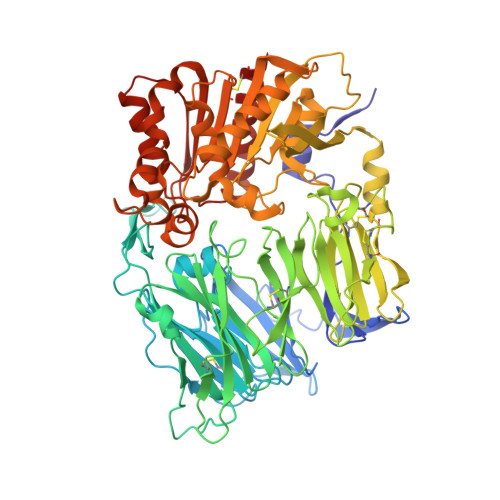Discovery, structure-activity relationship, and pharmacological evaluation of (5-substituted-pyrrolidinyl-2-carbonyl)-2-cyanopyrrolidines as potent dipeptidyl peptidase IV inhibitors.
Pei, Z., Li, X., Longenecker, K., Von Geldern, T.W., Wiedeman, P.E., Lubben, T.H., Zinker, B.A., Stewart, K., Ballaron, S.J., Stashko, M.A., Mika, A.K., Beno, D.W., Long, M., Wells, H., Kempf-Grote, A.J., Madar, D.J., McDermott, T.S., Bhagavatula, L., Fickes, M.G., Pireh, D., Solomon, L.R., Lake, M.R., Edalji, R., Fry, E.H., Sham, H.L., Trevillyan, J.M.(2006) J Med Chem 49: 3520-3535
- PubMed: 16759095
- DOI: https://doi.org/10.1021/jm051283e
- Primary Citation of Related Structures:
2G5P, 2G5T, 2G63 - PubMed Abstract:
A series of (5-substituted pyrrolidinyl-2-carbonyl)-2-cyanopyrrolidine (C5-Pro-Pro) analogues was discovered as dipeptidyl peptidase IV (DPPIV) inhibitors as a potential treatment of diabetes and obesity. X-ray crystallography data show that these inhibitors bind to the catalytic site of DPPIV with the cyano group forming a covalent bond with the serine residue of DPPIV. The C5-substituents make various interactions with the enzyme and affect potency, chemical stability, selectivity, and PK properties of the inhibitors. Optimized analogues are extremely potent with subnanomolar K(i)'s, are chemically stable, show very little potency decrease in the presence of plasma, and exhibit more than 1,000-fold selectivity against related peptidases. The best compounds also possess good PK and are efficacious in lowering blood glucose in an oral glucose tolerance test in ZDF rats.
Organizational Affiliation:
Department of Exploratory Pharmacokinetics and Pharmaceutics, Metabolic Disease Research, Global Pharmaceutical Research and Development, Abbott Laboratories, 100 Abbott Park Road, Abbott Park, Illinois 60064-3500, USA. [email protected]















